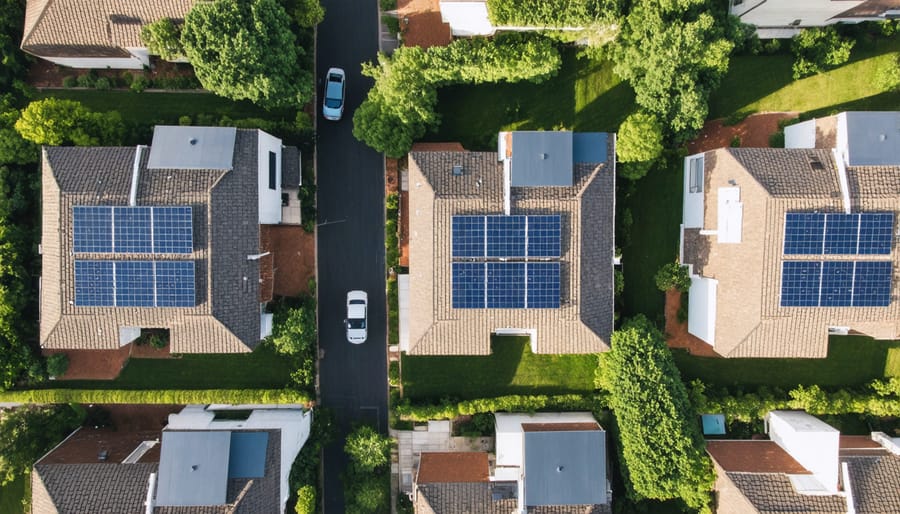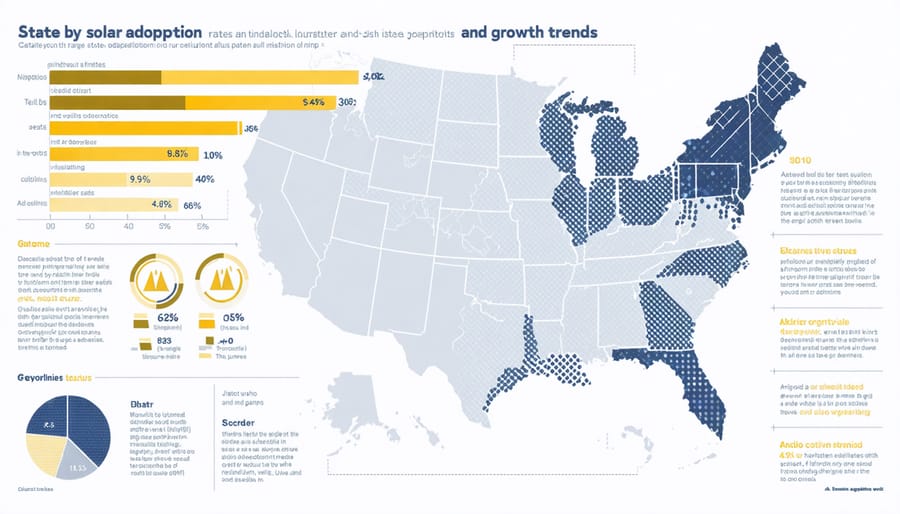U.S. Solar Battery Revolution: How American Homes Are Reshaping Energy Storage

The U.S. residential solar market stands at a pivotal crossroads, experiencing unprecedented growth as homeowners increasingly embrace clean energy solutions. In 2023, the sector witnessed a remarkable 40% expansion, with over 700,000 American households transitioning to solar power despite economic headwinds and supply chain challenges. This surge reflects a fundamental shift in America’s energy landscape, driven by falling installation costs, enhanced battery storage capabilities, and generous federal tax incentives under the Inflation Reduction Act.
What makes this market transformation particularly noteworthy is its ripple effect across the global renewable energy sector. European manufacturers, technology providers, and investors are finding substantial opportunities in America’s residential solar ecosystem, contributing to a robust trans-Atlantic clean energy partnership. The integration of smart home technologies, virtual power plants, and advanced energy management systems has transformed simple rooftop installations into sophisticated energy hubs.
As the market matures, innovative financing models and streamlined installation processes are making solar more accessible to middle-class homeowners, while technological advancements in panel efficiency and battery storage continue to improve the value proposition. This dynamic interplay of technology, policy, and market forces signals a new era in residential energy independence, with implications reaching far beyond American shores.
The Expanding U.S. Residential Solar Landscape
Market Size and Growth Trends
The U.S. residential solar market has demonstrated remarkable growth, with installations reaching 5.9 GW of capacity in 2022, representing a 40% increase from the previous year. This expansion reflects a broader trend of increasing adoption among American homeowners, with over 4 million residential solar installations now active across the country.
Market analysts project continued robust growth, estimating that the residential solar sector will double in size by 2027, reaching an annual installation rate of approximately 11 GW. This trajectory is driven by multiple factors, including decreasing installation costs, which have fallen by more than 60% over the past decade, making solar increasingly accessible to middle-income households.
California remains the leading state for residential solar deployments, accounting for roughly 40% of new installations. However, emerging markets in states like Texas, Florida, and New York are showing significant growth potential, diversifying the geographical spread of installations across the country.
The Inflation Reduction Act of 2022 has further stimulated market growth by extending the 30% federal tax credit through 2032, providing long-term market stability. This policy framework, combined with rising electricity costs and increasing environmental awareness, has created favorable conditions for sustained market expansion.
European observers note particular interest in the U.S. market’s innovative financing models and installation practices, which often serve as benchmarks for developing solar markets worldwide.

Regional Adoption Patterns
California continues to lead the U.S. residential solar market, accounting for roughly 40% of all new installations. This dominance stems from favorable policies, high electricity rates, and a strong environmental consciousness among residents. Following California, states like Texas, Florida, and Arizona have emerged as significant markets, driven by abundant sunshine and increasingly attractive economics.
The Northeast region, particularly New York, Massachusetts, and New Jersey, shows robust growth despite lower solar irradiance. These states leverage strong incentive programs and high electricity costs to drive adoption. What’s particularly noteworthy for European observers is how these northern states achieve success rates comparable to sunnier European regions like Germany.
Emerging markets are developing in the Midwest and Southeast, where falling installation costs and supportive policies are making solar more accessible. States like Illinois, Virginia, and South Carolina have introduced ambitious renewable energy goals, creating new opportunities for residential solar growth.
Market maturity varies significantly by region, influenced by factors such as utility policies, local regulations, and grid infrastructure. Coastal states typically demonstrate more sophisticated market mechanisms and installation networks, while inland regions are rapidly developing their solar ecosystems.
The pattern of adoption often follows urban-to-suburban expansion, with city centers initially leading installation rates before spreading to surrounding communities. This pattern mirrors successful European solar markets, suggesting similar development trajectories despite different regulatory frameworks.

Battery Integration in U.S. Homes
Popular Battery Solutions
In the U.S. residential solar market, battery storage solutions have become increasingly sophisticated, offering homeowners enhanced energy independence and reliability. Tesla’s Powerwall continues to dominate the market, setting industry standards for residential battery storage capacity and smart features. The latest Powerwall 2 model delivers 13.5 kWh of usable energy, making it suitable for most household needs.
Enphase Energy’s IQ Battery system has gained significant traction, particularly among homeowners who value its modular design and microinverter technology. Available in 3.3 kWh and 10 kWh configurations, it offers flexibility for various home sizes and energy requirements.
LG Chem’s RESU series represents another popular choice, with their RESU10H providing 9.3 kWh of usable capacity. Known for reliability and compact design, these batteries integrate seamlessly with multiple inverter brands. Generac’s PWRcell system has emerged as a strong competitor, offering expandable capacity from 9 kWh to 36 kWh, appealing to homeowners seeking scalable solutions.
Recent innovations include smart energy management systems that optimize battery usage based on electricity rates and weather patterns. These advanced features, combined with declining prices and improved warranty terms, have made battery storage increasingly attractive for residential solar installations across the United States.
Installation and Integration Practices
The integration of battery storage systems with residential solar installations has become increasingly sophisticated in the U.S. market, offering valuable lessons for European implementations. Modern installations typically utilize smart inverters that enable seamless switching between solar, battery, and grid power. These systems incorporate advanced monitoring capabilities and automated battery system optimization features to maximize energy efficiency.
Installation practices generally follow a three-phase approach: system design and compatibility assessment, physical installation with safety protocols, and commissioning with performance verification. Retrofitting existing solar installations requires careful evaluation of the current setup, including inverter compatibility and available space for battery placement. Most U.S. installations now utilize DC-coupled systems, which offer higher overall efficiency compared to AC-coupled alternatives.
Key technical considerations include proper ventilation for thermal management, robust electrical isolation, and strategic placement for optimal performance. Modern installations incorporate rapid shutdown capabilities and sophisticated monitoring systems that provide real-time performance data and predictive maintenance alerts. The integration process typically takes 1-2 days for residential systems, with preliminary site assessments and necessary permitting completed beforehand.
Installers increasingly focus on future-proofing systems by ensuring expandability and compatibility with emerging smart home technologies, reflecting the growing trend toward comprehensive energy management solutions.

Cost-Benefit Analysis
The financial landscape of U.S. residential solar installations presents compelling opportunities for homeowners seeking home energy independence. Federal tax incentives currently offer a 30% Investment Tax Credit (ITC), significantly reducing initial installation costs. When combined with state-specific incentives and local utility rebates, homeowners can typically recover their investment within 5-8 years.
Average installation costs range from $15,000 to $25,000 for a standard 6kW system, though prices continue to decrease as technology advances and market competition intensifies. Monthly energy savings typically range from $100 to $200, depending on local electricity rates and consumption patterns. Over a 25-year period, the total savings can exceed $60,000 in regions with high utility costs.
Performance degradation averages only 0.5% annually, ensuring consistent returns throughout the system’s lifetime. Maintenance costs remain minimal, typically under $200 annually for basic inspections and cleaning. Property value increases average 4.1% with solar installation, offering additional financial benefits beyond direct energy savings.
Net metering policies in most states further enhance ROI by allowing homeowners to sell excess power back to the grid, though specific arrangements vary by region. When considering financing options, many homeowners opt for solar loans with interest rates between 3-7%, making immediate positive cash flow possible while avoiding large upfront costs.
Market Challenges and Opportunities
Infrastructure and Policy Landscape
The U.S. residential solar market operates within a complex framework of federal, state, and local policies that significantly influence its growth. The Investment Tax Credit (ITC) remains a cornerstone of federal support, offering homeowners substantial tax benefits for solar installations. At the state level, policies like net metering and renewable portfolio standards create additional incentives, though these vary significantly across different regions.
Grid infrastructure plays a crucial role in market development, with utilities adapting to increasing distributed energy resources. Many states are modernizing their grid systems to accommodate bidirectional power flows and smart energy management systems. This transformation includes upgraded transformers, advanced metering infrastructure, and enhanced grid stability measures.
Recent policy developments, such as the Inflation Reduction Act of 2022, have strengthened the market’s foundation by extending and expanding solar incentives. However, interconnection challenges persist in some regions, where aging grid infrastructure requires substantial upgrades to support growing solar adoption.
Building codes and permitting processes continue to evolve, with many jurisdictions streamlining solar installation approvals. Some states have implemented solar-ready building requirements for new construction, while others focus on standardizing permitting procedures to reduce soft costs and installation timelines.
For European observers, these infrastructure and policy frameworks offer valuable insights into market development and regulatory approaches that could inform similar initiatives in European markets.
Future Market Projections
The U.S. residential solar market is poised for substantial growth through 2030, with projections indicating a compound annual growth rate of 15-20%. This expansion is driven by decreasing installation costs, improved emerging battery technologies, and supportive federal policies like the Inflation Reduction Act.
Industry analysts forecast that by 2025, approximately 20% of all new American homes will include integrated solar installations, representing a significant shift in construction practices. Smart home integration and virtual power plant capabilities are expected to become standard features, enhancing the value proposition for homeowners.
The market is also likely to see increased competition among installers and equipment manufacturers, potentially leading to further cost reductions and innovative financing solutions. European manufacturers and technology providers are well-positioned to capitalize on this growth, particularly in premium segments where quality and efficiency are paramount.
Key growth opportunities include the expansion of solar-plus-storage systems, development of AI-driven energy management platforms, and the introduction of building-integrated photovoltaics (BIPV) solutions. The sector is expected to create over 200,000 new jobs by 2027, with particular demand for skilled technicians and system designers.
Regulatory frameworks are anticipated to evolve, with many states expected to implement additional incentives and streamlined permitting processes, further accelerating market adoption.
The U.S. residential solar-plus-storage market stands at a pivotal moment, demonstrating remarkable resilience and growth potential despite economic fluctuations. As battery technology costs continue to decline and energy security concerns intensify, the integration of storage solutions with residential solar installations has become increasingly mainstream. Market projections indicate sustained growth through 2030, driven by favorable policies, improved technology, and growing consumer awareness.
Key trends shaping the future include the standardization of installation processes, enhanced grid integration capabilities, and the emergence of smart home energy management systems. The success of virtual power plants and community solar projects highlights the evolving nature of residential solar applications, pointing toward a more interconnected and efficient energy ecosystem.
For European stakeholders, the U.S. market offers valuable insights into scaling residential solar adoption and storage integration. The American experience with diverse climate conditions, regulatory frameworks, and consumer preferences provides practical lessons for European markets developing similar solutions.
Looking ahead, the sector faces both opportunities and challenges. While supply chain resilience and workforce development remain crucial factors, innovations in financing models and installation efficiency continue to make solar-plus-storage more accessible to homeowners. The increasing focus on resilience and energy independence, coupled with declining costs and technological improvements, suggests a promising future for residential solar-plus-storage systems in the United States.
Leave a Reply